Juicy chicken thighs, peaches, balsamic vinegar, maple syrup and rosemary come together in our one-pan Low FODMAP Balsamic Chicken with Peaches. This recipe is based upon our incredibly popular Low FODMAP Maple Balsamic Chicken with Roasted Blueberries. If you love that dish, you gotta try this one – if you have passed your sorbitol Challenge. More on that below.
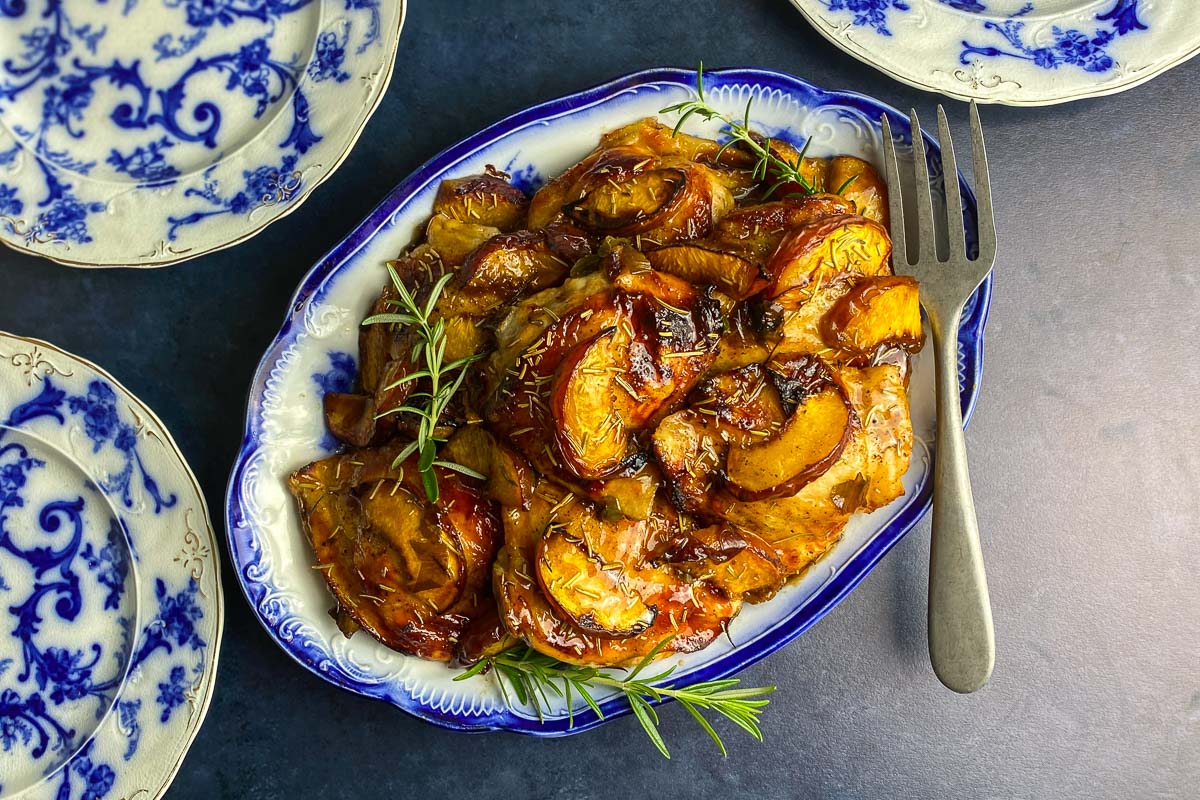
You Are In For A Treat
My husband is the chief taste-tester in the sense that he tries every single thing that comes out of our Test Kitchen. He said that not only was this the best chicken dish I had ever made – but that it might be the most delicious things I have ever made…frankly, that is saying a lot! I think you will enjoy this as much as we did.
The Challenge Phase Is Important
The term “low FODMAP diet” is often used incorrectly. The low FODMAP diet has 3 phases: Elimination, Challenge and Integration, but the term “low FODMAP diet” is often mistakenly used to describe the initial Elimination Phase, which is meant to be brief. It is truly just one part of the diet.
It is very important for your gut health to move beyond this first restrictive step and onto the Challenge Phase. It is during the Challenge Phase that you will learn what your personal relationship is to various foods, FODMAPs and serving sizes.
The goal of the diet over all is to help you learn what your IBS triggers are, keep you symptom-free (or close to it), help you eat as broadly as possible and leave you with a healthy relationship to food.
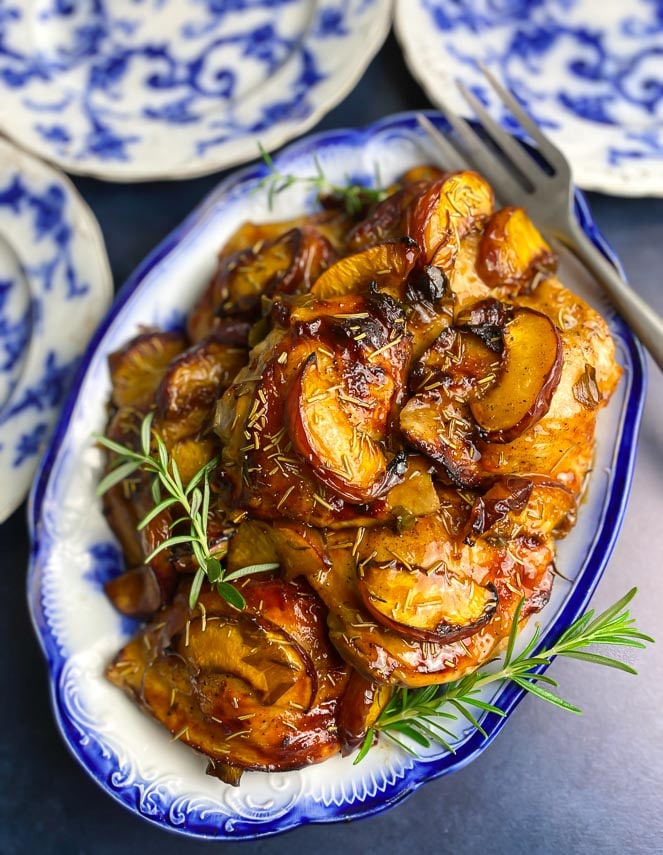
Yellow Peaches Contain Sorbitol
Yellow peaches contain sorbitol according to Monash University lab testing. Yellow peaches are low FODMAP in 30 g amounts. When you test Polyols, you will discover just how much Polyol content you can tolerate and will hopefully divide your Challenges into testing yourself for tolerance to sorbitol as well as mannitol.
We know if can appear confusing and we strongly suggest doing your Challenges with a Registered Dietitian to help guide you.
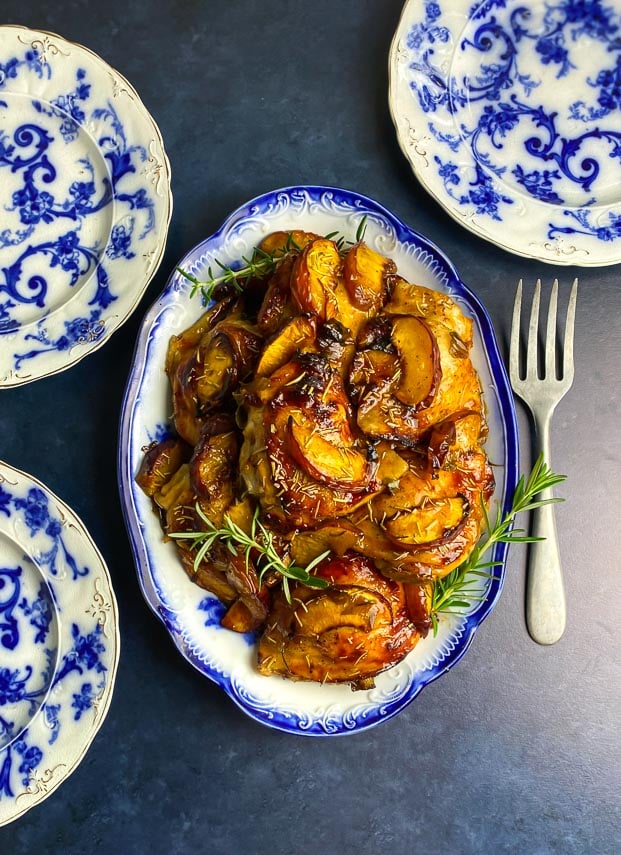
This Recipe Is For You If You Have Passed Your Sorbitol Challenge
This recipe contains a fair amount of yellow peaches and we suggest it for those who have passed their Challenge for sorbitol. You could also try our Low FODMAP Peach Crisp.
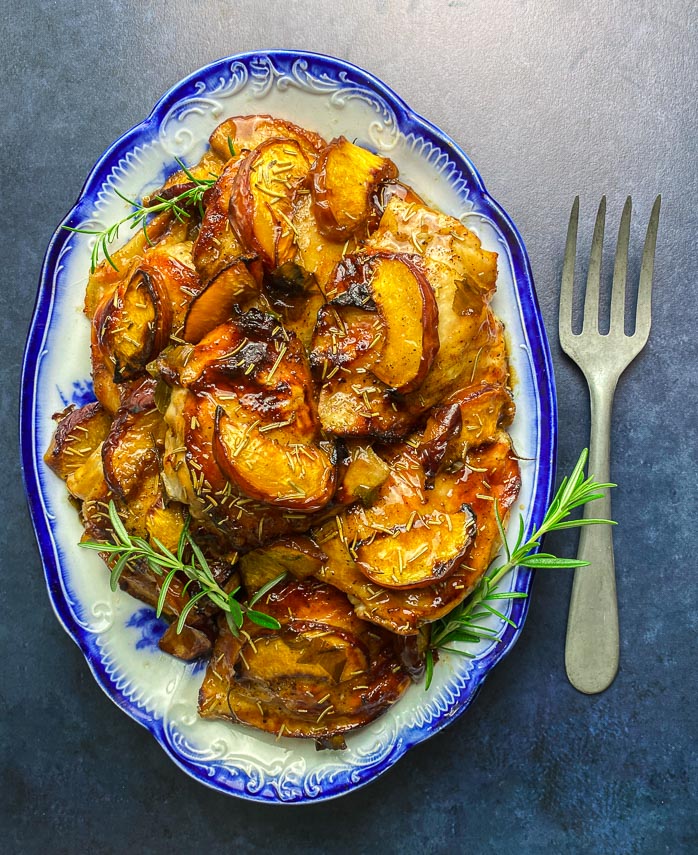
Frequently Asked Questions
FODMAP is an acronym for Fermentable Oligosaccharides, Disaccharides, Monosaccharides and Polyols.
Polyols are small-chain carbohydrates that occur naturally in certain fruits and vegetables and are used as additives in prepared foods. The two Polyols that have been extensively evaluated by the Monash University researcher are sorbitol and mannitol.
Read more in our article, What Are Polyols? Learn All About the “P” in FODMAP!
Monash University has lab tested both white and yellow peaches and reported their findings in their smartphone app. Yellow peaches have a more generous low FODMAP serving size, so we used them in this recipe.
You can read more in our article, Are Peaches Low FODMAP?
We love the sweet tangy taste and rich texture of balsamic vinegar, but it gets a bad rap in the FODMAP world. This is probably because when you first look it up in the Monash University app it sports a Moderate FODMAP Yellow Light. But as with ALL entries, we always encourage you to click through to view the entire entry. There you will see that there is a low FODMAP serving.
In fact, both Monash and FODMAP Friendly have lab tested balsamic vinegar.
Monash has lab tested balsamic vinegar and their findings determined a low FODMAP serving of 1 Australian tablespoon or 21 g.
FODMAP Friendly lab tests place balsamic vinegar as low FODMAP in servings of 2 ½ tablespoons or 42 ml.
If you stick with the serving sizes of our Balsamic Chicken with Peaches, you will be eating a low FODMAP amount of balsamic vinegar.
The right equipment can make a huge difference in how well a recipe turns out. Commercial kitchens tend to use sturdy equipment that work hard for the cook, but not all of them translate to the home kitchen (like 60-quart mixers!). Luckily, half-sheet pans are inexpensive, and we think they are a must-have for any cook – professional or home cook.
Sturdy, aluminum rimmed pans (18 x 13 x 1-inch) are called “half-sheet” pans. So-called because full sized sheet pans are the size that fit in commercial ovens -but not your home oven. When I worked on my first cookie book, I did a serious side-by-side test of many sheet pans, and half-sheet pans won out by a landslide.
They are the perfect pan for your cookies but also jellyroll cakes, large batch brownies, roasting meats, chicken, fish, oven-fries, vegetables and more. Use them to catch drips under your juicy pies!
Here they are used in this easy to make one-pan Low FODMAP Balsamic Chicken with Peaches.
Whatever you use, make sure there is room around each chicken thigh or they won’t cook properly.
We eat a lot of chicken, but not just any chicken. We are huge fans of air-chilled chicken.
Air-chilled chicken is created by passing the birds through several chambers where cold, purified air is used to cool the meat. This results in a dryer chicken, with better flavor and even reduces bacteria. One University of Nebraska study found 80% less bacteria than found in water-chilled chicken (which is the other way of processing).
You know how sometimes you buy chicken in a package and there is a lot of moisture, so much that you have to pour it off? That won’t happen with air-chilled.
Buy it if you can; the label should state this.
How To Make Low FODMAP Balsamic Chicken With Peaches
Position rack in top third of oven. Preheat oven to 375°F (190°C).
Scatter chopped scallions all over half-sheet pan.
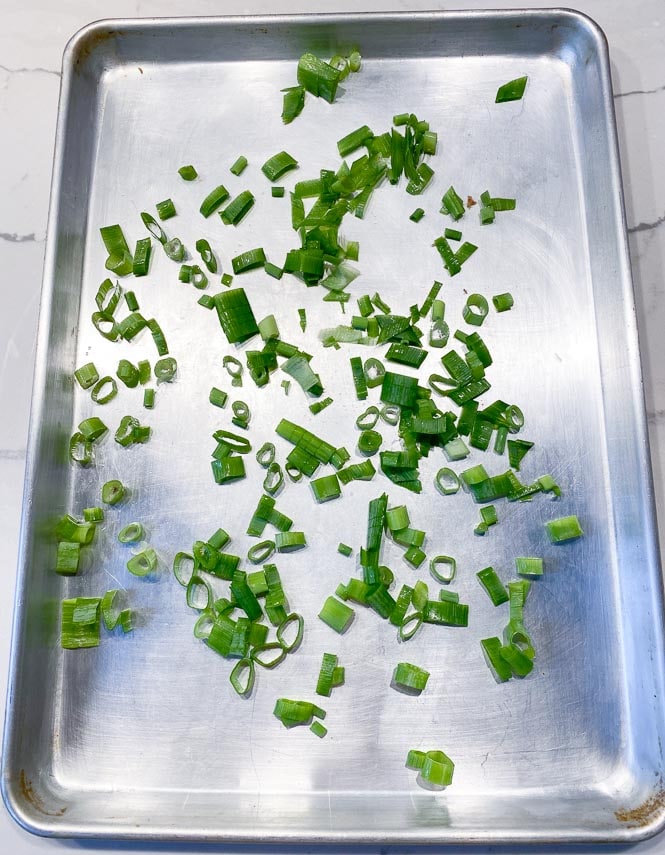
Arrange chicken in a single layer on top of scallions and season generously with salt and pepper.
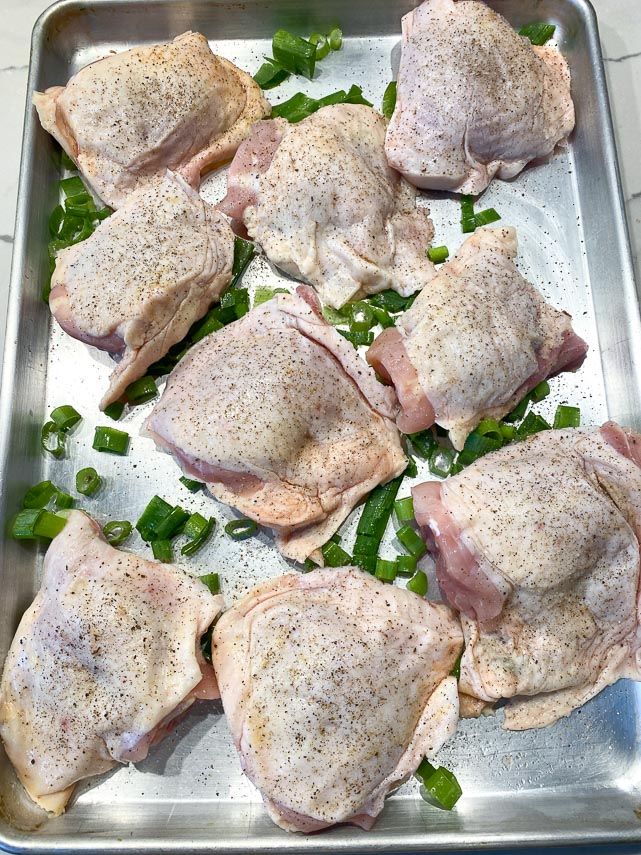
You can leave skin on the peaches. I like the added color and texture.

Scatter peaches about (I placed one wedge on each chicken thigh) and Drizzle ingredients with balsamic vinegar and maple syrup.
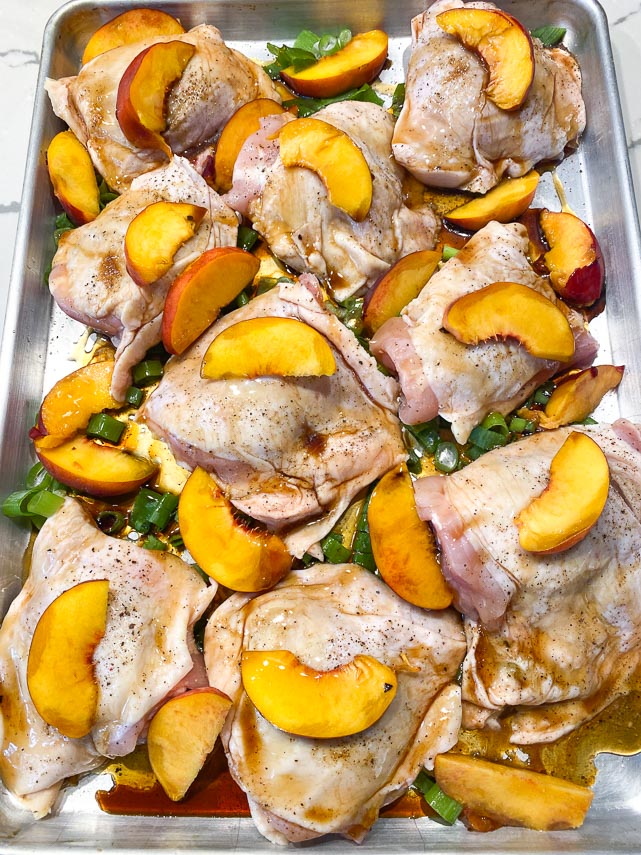
Crush rosemary between fingertips and sprinkle overall.
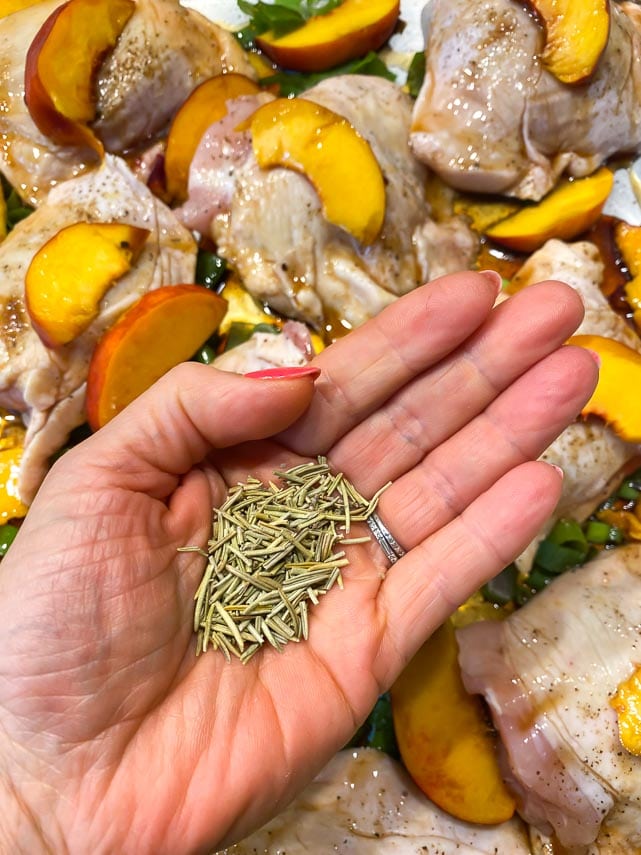
If you have some fresh rosemary you can tuck a few spring here and there (and reserve some for garnish), but it is not necessary.
Your chicken is ready for the oven!
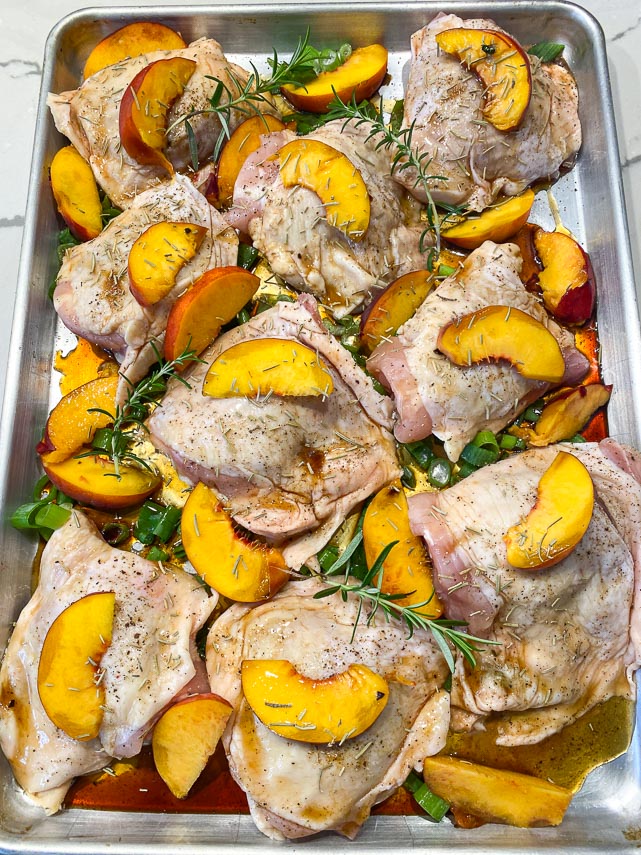
Roast in oven for 35 to 45 minutes or until chicken is cooked through, skin is crispy, and the dish is saucy.
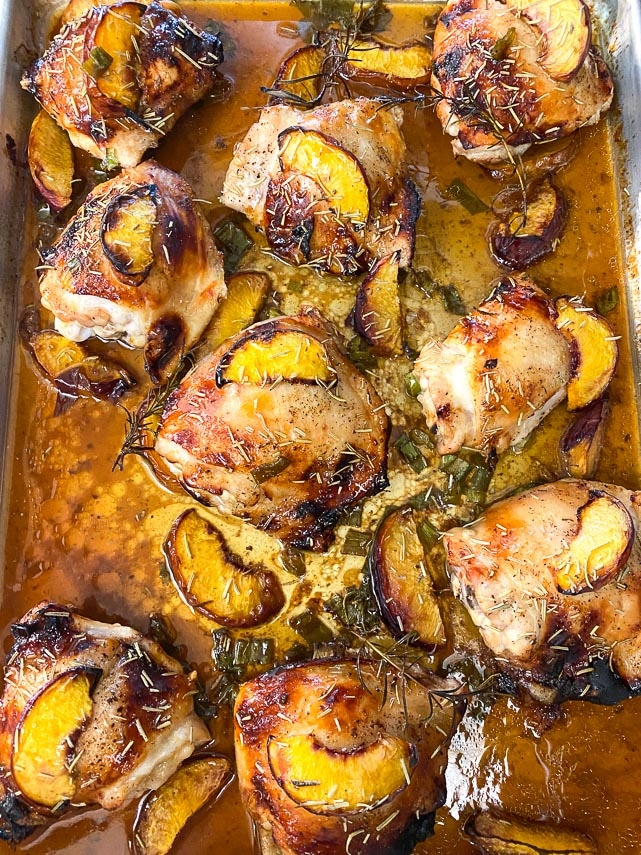
Allow chicken to rest while you pour off the sauce into a small pot, skim-off excess fat, and boil for a few minutes or until thickened and reduced; it will turn glossy.
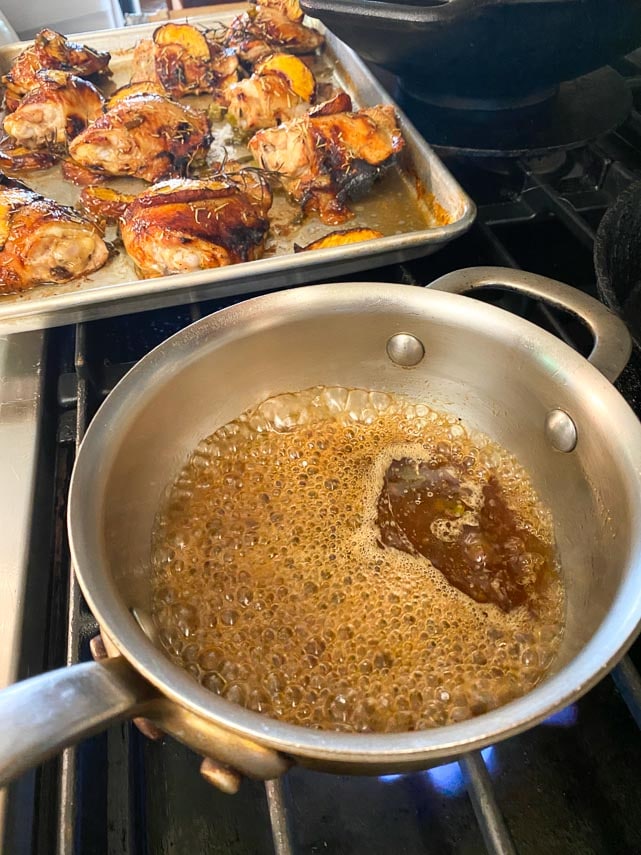
Reduce until as thick as maple syrup – even a little thicker!
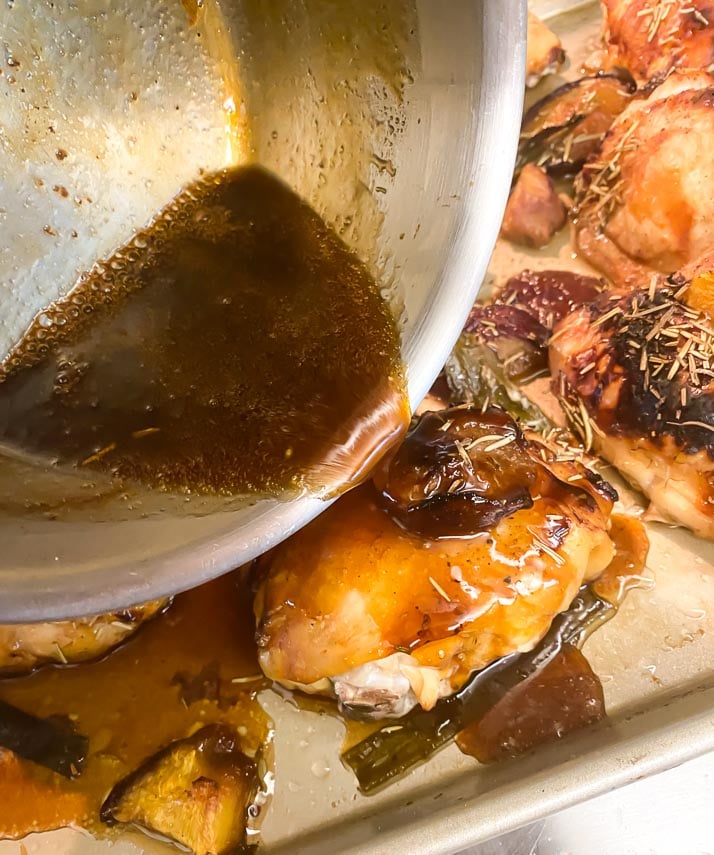
Brush or pour this thickened glaze over the chicken and serve. We love this dish served with rice and a green vegetable- or mashed potatoes.
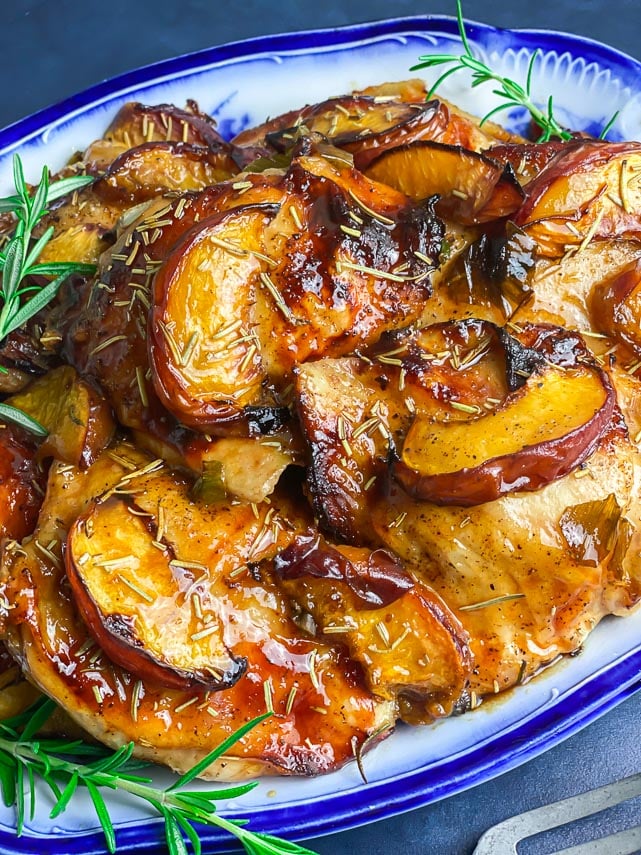
FODMAP Information
Our recipes are based on Monash University and FODMAP Friendly science.
- Maple Syrup: Both Monash University and FODMAP Friendly have lab tested maple syrup. Monash says that maple syrup is Green light and low FODMAP in servings of 2 Australian tablespoons (50 g). FODMAP Friendly gives it a “Pass” at 2 tablespoons (53 g). These amounts are likely recommended due to Australian healthy eating guidelines; no upper limit is posted by either Monash or FODMAP Friendly.
- Scallions: The green parts of scallions are low FODMAP as determined by Monash University lab testing and can be used to add onion flavor to your low FODMAP cooking.
- Vinegar: Several vinegars have been lab tested by both Monash and FODMAP Friendly. From Monash: Apple cider vinegar is low FODMAP at 2 Australian tablespoons or 42 g; Balsamic vinegar is low FODMAP at 1 Australian tablespoons or 21 g; Malt vinegar contains no FODMAPs; Rice wine vinegar is low FODMAP at 2 Australian tablespoons or 42 g. From FODMAP Friendly: Balsamic gets a “Pass” at 2.5 tablespoons or 42 ml. Apple cider vinegar gets a “Pass” at 1 tablespoon or 14 g (don’t ask me why one is in milliliters and the other in grams).
Please always refer to the Monash University & FODMAP Friendly smartphone apps for the most up-to-date lab tested information. As always, your tolerance is what counts; please eat accordingly. The ultimate goal of the low FODMAP diet is to eat as broadly as possible, without triggering symptoms, for the healthiest microbiome.
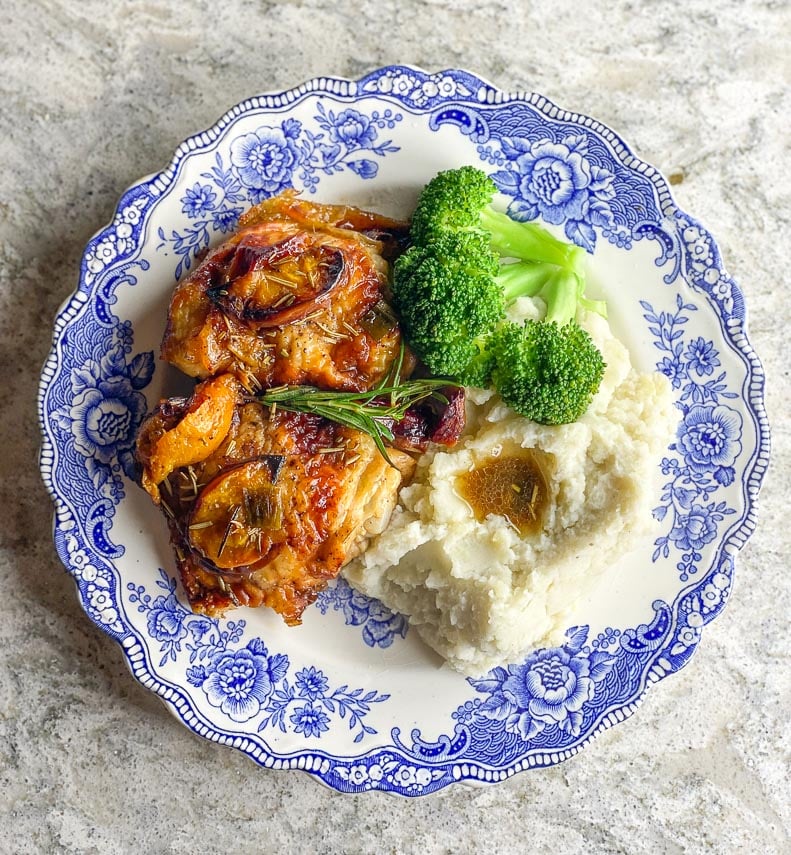
Winner, Winner – Chicken Dinner!
We have heard you loud and clear. You folks love chicken! We have a an entire post dedicated to you. Come check out Our Favorite Low FODMAP Chicken Recipes.
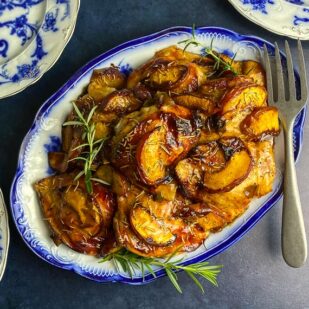
Low FODMAP Balsamic Chicken with Peaches
Juicy chicken thighs, peaches, balsamic vinegar, maple syrup and rosemary come together in our one-pan Low FODMAP Balsamic Chicken with Peaches. This recipe is based upon our incredibly popular Low FODMP Maple Balsamic Chicken with Roasted Blueberries. If you love that dish, you gotta try this one – if you have passed your sorbitol Challenge. More on that below.
Ingredients:
- 1 cup (64 g) roughly chopped scallions, green parts only
- 3 ½- pounds (1.6 kg) chicken thighs, bone-in, skin on, preferably air-chilled, patted dry
- Kosher salt
- Freshly ground black pepper
- 3 medium-sized ripe yellow peaches, cut into ½-inch (12 mm) wedges, skin on
- ¼ cup (60 ml) balsamic vinegar
- ¼ cup (60 ml) maple syrup
- 1 ½ teaspoons dry rosemary
- Fresh rosemary sprigs; optional
Preparation:
-
Position rack in top third of oven. Preheat oven to 375°F (190°C).
-
Scatter chopped scallions all over half-sheet pan. Arrange chicken in a single layer – with room in-between – on top of scallions and season generously with salt and pepper. Scatter peaches about (I placed one wedge on each chicken thigh), then drizzle ingredients with balsamic vinegar and maple syrup. Crush rosemary between fingertips and sprinkle overall.
-
Roast in oven for 35 to 45 minutes or until chicken is cooked through, skin is crispy, and the dish is saucy. Allow chicken to rest while you pour off the sauce into a small pot, skim-off excess fat, and boil for a few minutes or until thickened and reduced; it will turn glossy. It should be the texture of mapkle syrup or even a bit thicker. Brush this thickened glaze over the chicken and serve. We love this dish served with rice and a green vegetable- or mashed potatoes!
Notes:
FODMAP Information
Our recipes are based on Monash University and FODMAP Friendly science.
• Maple Syrup: Both Monash University and FODMAP Friendly have lab tested maple syrup. Monash says that maple syrup is Green light and low FODMAP in servings of 2 Australian tablespoons (50 g). FODMAP Friendly gives it a “Pass” at 2 tablespoons (53 g). These amounts are likely recommended due to Australian healthy eating guidelines; no upper limit is posted by either Monash or FODMAP Friendly.
• Scallions: The green parts of scallions are low FODMAP as determined by Monash University lab testing and can be used to add onion flavor to your low FODMAP cooking.
• Vinegar: Several vinegars have been lab tested by both Monash and FODMAP Friendly. From Monash: Apple cider vinegar is low FODMAP at 2 Australian tablespoons or 42 g; Balsamic vinegar is low FODMAP at 1 Australian tablespoons or 21 g; Malt vinegar contains no FODMAPs; Rice wine vinegar is low FODMAP at 2 Australian tablespoons or 42 g. From FODMAP Friendly: Balsamic gets a “Pass” at 2.5 tablespoons or 42 ml. Apple cider vinegar gets a “Pass” at 1 tablespoon or 14 g (don’t ask me why one is in milliliters and the other in grams).
Please always refer to the Monash University & FODMAP Friendly smartphone apps for the most up-to-date lab tested information. As always, your tolerance is what counts; please eat accordingly. The ultimate goal of the low FODMAP diet is to eat as broadly as possible, without triggering symptoms, for the healthiest microbiome.
Nutrition
All nutritional information is based on third-party calculations and should be considered estimates. Actual nutritional content will vary with brands used, measuring methods, portion sizes and more. For a more detailed explanation, please read our article Understanding The Nutrition Panel Within Our Recipes.
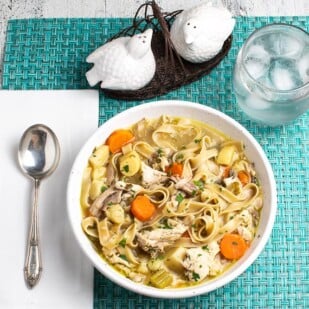
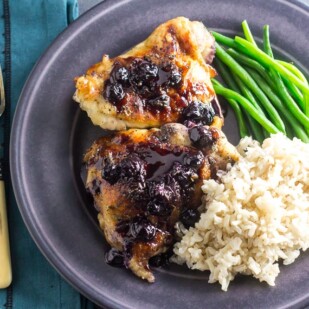




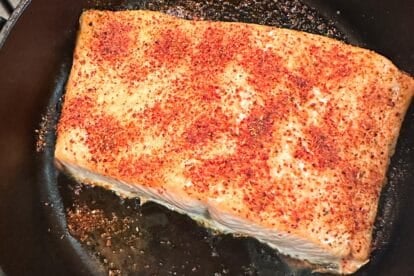
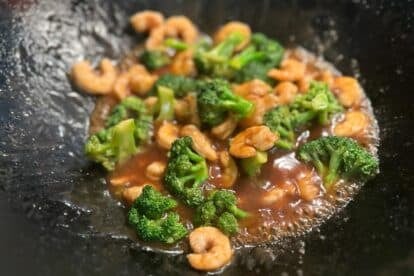
Very yummy and super easy. I would definitely make this again!
MMMMmmmmm so glad you made this! I have already made it twice to great reviews – even from non-FODMAPers. It is so easy and you get BIG FLAVOR! Thank you for writing.
I am wondering how the peaches can be added, it’s my understanding that they are high fodmap. Is it the portion ratio that allows them and how would one judge that if they were making their own meal from scratch. Thank you for your insights and expertise.
Hi there! Thank you for asking. According to lab tests by Monash University, the developers of the diet, yellow peaches and white peaches have different FODMAP amounts, with yellow peaches having a more generous low FODMAP serving size. Yellow peaches are low FODMAP in 30 g amounts. You can read more HERE in our peach article. This recipe has more peaches per serving than 30 grams, which is why it shows at the top that the dish contains Polyols (That is the “P” icon). We also discuss in depth throughout the article that, “This Recipe Is For You If You Have Passed Your Sorbitol Challenge”. This is not an Elimination stage recipe. 99.9% of the recipes on the site are. I think at this point we have maybe 4 out of 1000 that are not.